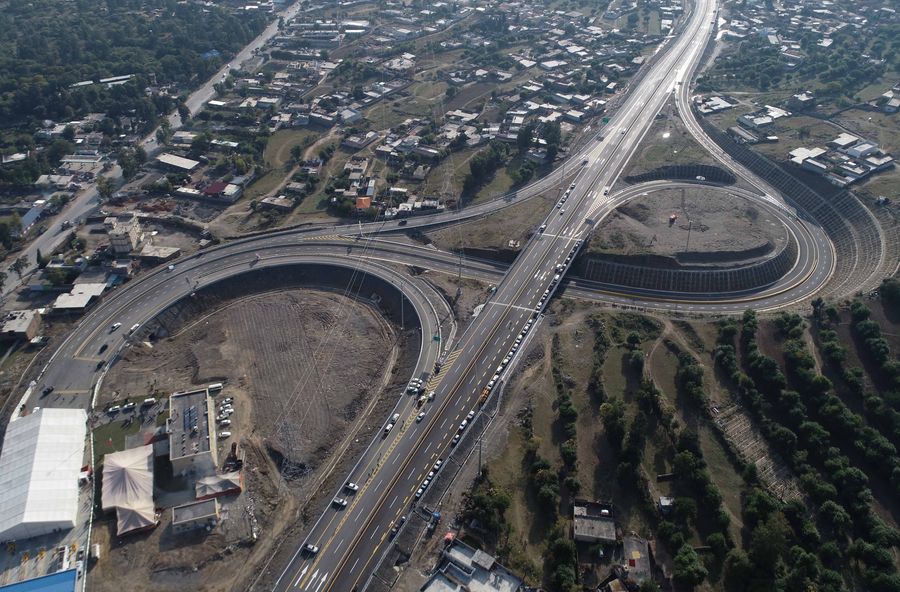
The expressway section of the Karakorum Highway (KKH) project phase two in Pakistan, Nov. 18, 2019. (Xinhua/Liu Tian)
Policy head of the Islamabad-based think-tank told Xinhua that they have conducted a study to assess employment opportunities in four out of nine SEZs to find out the potential jobs and industries.
Unemployment being one of Pakistan's major challenges, he believes the trained and skilled workers will get good jobs, enabling Chinese and local companies to find skilled professionals from local areas.
by Misbah Saba Malik
ISLAMABAD, Nov. 29 (Xinhua) -- The China-Pakistan Economic Corridor (CPEC) is likely to create about 575,000 direct and over 1 million indirect jobs in four special economic zones (SEZs) to be set up in Pakistan's Khyber Pakhtunkhwa (KP), Punjab, Sindh and Balochistan provinces, an official from the CPEC Center of Excellence said.
Muhammad Muzammil Zia, policy head of job growth and human resource development in the Islamabad-based think-tank under the Ministry of Planning, Development and Reform, said the forthcoming second phase of CPEC will bring immense opportunities for Pakistani people in job and business sectors.
"We have conducted a study to assess employment opportunities in four out of nine SEZs including KP's Rashakai, Sindh's Dhabeji, Punjab's Allama Iqbal and Balochistan's Bostan, with the state-run National Vocational and Technical Training Commission (NAVTTC) to find out potential jobs and industries in the SEZs," he told Xinhua.
"We found out that the SEZs offer employments in different fields for which the local youth should be trained before the initiation of the industrial phase."
The result of the study will help the NAVTTC and provincial Technical Education and Vocational Training Authorities (TEVTAs) to equip local youth with skills in the respective fields.

Pakistani youth celebrate during a ceremony at the mausoleum of the founder of Pakistan Muhammad Ali Jinnah to mark the country's Independence Day in southern Pakistani port city of Karachi, on Aug. 14, 2019. (Str/Xinhua)
Sharing the initial details of the possible industries in the SEZs, based on the letter of intentions and applications to buy plots in the industrial areas, Zia said the major industries in Punjab's Allama Iqbal SEZ are expected to be textile, light engineering, pharmaceutical, steel, food processing and chemicals with a potential to create 290,000 direct jobs.
KP's Rashakai SEZ whose groundbreaking is likely to take place in December this year is likely to directly employ 150,000 people in light engineering, marble, plastic and packing, gem and jewelry, food processing and steel industries.
With potential industries including food processing, cooking oil, ceramics, gems and jewelry, marble, minerals, agriculture machinery, iron and steel, motorbike assembling, electrical appliances and automobile, Balochistan's Bostan SEZ is likely to produce 55,000 jobs for locals, Zia added.
Sindh's Dhabeji SEZ has a potential to create 80,000 jobs with potential industries including food and beverages, pharmaceutical, electronics, automobile and plastic related products.

Pakistan's Federal Minister for Planning, Development and Reforms Makhdoom Khusro Bakhtiar addresses the annual conference of the China-Pakistan Economic Corridor (CPEC) Consortium of Universities in Islamabad, capital of Pakistan, Nov. 18, 2019. (Xinhua/Ahmad Kamal)
In the first phase of CPEC, some Chinese companies faced problems in finding suitable people to work on energy and infrastructural projects because there is an acute lack of skilled laborers in Pakistan, he said.
In order to prepare Pakistani youth to find employment opportunities in the second phase of CPEC, the NAVTTC is planning to conduct short-term courses to train the aspirants in the respective fields, for which they align their future courses accordingly, the official said.
Unemployment is one of the major challenges which the Pakistani government is facing. According to recent statistics of the World Bank, about 6 percent Pakistanis are unemployed. And to solve this issue, Pakistan needs to create more jobs in the future.
Zia believes that the trained and skilled labor and engineers will not only get good jobs in the SEZs, but also enable Chinese and local companies to find skilled professionals from local areas rather than hiring them from other parts of the country.

Pakistani Minister of Planning, Development and Reforms Khusro Bakhtiar speaks during the ninth Joint Cooperation Committee (JCC) meeting of the China-Pakistan Economic Corridor (CPEC) in Islamabad, Pakistan, Nov. 5, 2019. (Xinhua/Ahmad Kamal)
Talking about the situation of skilled professionals in the country, he said the NAVTTC and TEVTAs are not satisfied with the current abilities of the skilled labor in Pakistan, adding that restructuring and upgradation of the structure of the national technical training institutes is the need of the hour to facilitate the forthcoming industrial zones.
"There is also a need for a CPEC consortium of technical and vocational institutes where both Chinese and Pakistani technical institutes should sit together to assess the future technical demand and collaborate together for the training of Pakistani students and trainers with China's state-of-the-art technology to facilitate the SEZs in Pakistan."
In the first phase of CPEC, scores of Pakistani professionals were sent to China for weeks or months-long training for working on energy projects.
The "Job Creation Estimates and Workforce Profiling" study by the CPEC Center of Excellence will be formally launched next month in Islamabad, following which the NAVTTC and TEVTAs will initiate courses and technical skills for respective jobs. ■



